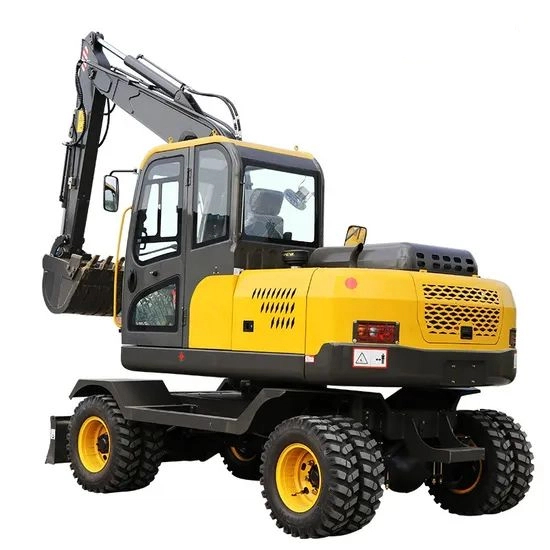There are obvious differences between wheeled excavators and crawler excavators in terms of structural design and applicable scenarios. The specific differences are as follows:

1. Travel Mode and Chassis Structure
Wheeled Excavators
- Chassis Structure: Adopt a tire-type chassis with multiple wheels (usually 4 or 6 wheels), which are connected to the frame through a suspension system.
- Travel Characteristics: Driven by tire-to-ground contact, with a faster speed (generally up to 20-40 km/h). They are suitable for long-distance movement on highways and hardened roads, do not require trailer transportation, and have flexible site transfer.
Crawler Excavators
- Chassis Structure: Adopt a crawler chassis composed of two continuous tracks surrounding drive wheels, guide wheels, idlers, etc.
- Travel Characteristics: Moving through the friction between the tracks and the ground, with a slower speed (generally no more than 5-10 km/h). However, the tracks have a large ground contact area and low ground pressure, making them suitable for driving on complex terrains such as muddy, soft, and rough surfaces, with strong cross-country capability.
2. Applicable Scenarios and Terrains
Wheeled Excavators
- Applicable Scenarios: Mainly used in urban road construction, municipal engineering, landscaping, concrete crushing, and other scenarios requiring frequent site transfers.
- Terrain Limitations: They perform best on flat or hardened roads. In soft terrains such as mud and sand, they are prone to slipping and have poor passability.
Crawler Excavators
- Applicable Scenarios: Widely used in field operations such as mining, farmland renovation, water conservancy projects, and building foundation excavation, especially suitable for scenarios requiring long-term work in harsh terrains.
- Terrain Advantages: Tracks can effectively disperse the weight of the machine, making it less likely to get stuck in complex terrains such as swamps, mountains, and steep slopes, with strong stability.
3. Operational Performance and Efficiency
Wheeled Excavators
- Excavation Capacity: Usually with a smaller tonnage (commonly 5-20 tons), relatively weaker excavation and loading capabilities, suitable for earthwork excavation, loading, and other operations in medium and small projects.
- Flexibility: The body has flexible steering and can operate in narrow spaces (such as urban streets and indoor demolition). Moreover, the tire travel noise is low, making it suitable for scenarios with high noise and environmental requirements.
Crawler Excavators
- Excavation Capacity: The tonnage covers a wide range (10-100 tons and above). Large-tonnage models have strong excavation power and can handle high-intensity operations such as rock crushing and heavy loading.
- Stability: The crawler chassis provides stronger support. When operating on slopes or uneven ground, the body stability is better than that of wheeled excavators, suitable for long-term continuous operations.
4. Maintenance and Usage Costs
Wheeled Excavators
- Maintenance Costs: Tires wear quickly, especially when driving on rough roads, and the cost of replacing tires is high. However, the chassis structure is relatively simple, and the suspension system is easy to maintain.
- Usage Costs: Lower fuel consumption (fast driving speed and small engine load), and no trailer is needed for site transfer, saving transportation costs.
Crawler Excavators
- Maintenance Costs: Crawler components (such as track chains and idlers) are used in harsh environments for a long time, resulting in serious wear and high maintenance and replacement costs. The chassis structure is complex, and maintenance is difficult.
- Usage Costs: Higher fuel consumption (slow driving speed and heavy engine load), and trailer transportation is required for site transfer, increasing transportation costs and time costs.
5. Other Differences
| Comparison Dimension | Wheeled Excavators | Crawler Excavators |
|---|---|---|
| Body Weight | Lighter, suitable for highway driving | Heavier, relying on crawler support |
| Ground Damage | Tires cause less damage to hardened roads | Crawlers may damage paved roads |
| Noise and Vibration | Lower driving noise and vibration | Higher driving noise and vibration |
| Price | Relatively lower overall price | Higher price for large-tonnage models |
Conclusion
Wheeled excavators excel in "flexibility and highway adaptability," making them suitable for urban operations and frequent site transfers. Crawler excavators focus on "cross-country capability and stability," ideal for high-intensity field construction. The selection should be comprehensively considered based on specific operating scenarios, terrain conditions, construction requirements, and cost budgets.





